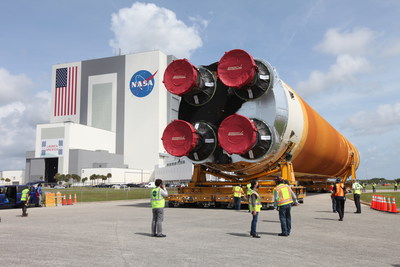Jacobs and NASA Begin Processing of Space Launch System Core Stage, Received Final Piece of Artemis I Flight Hardware
Jacobs has commenced processing the Space Launch System (SLS) core stage after its delivery to Kennedy Space Center on April 28, 2021. This marks a pivotal milestone for the Artemis I mission, which will test an uncrewed Orion spacecraft around the Moon. Jacobs, as NASA's prime contractor, is pivotal in integrating components and ensuring launch readiness. The SLS, with a thrust of 8.8 million pounds, is poised to be NASA's most powerful rocket. Jacobs achieved $14 billion in revenue, employing approximately 55,000 people, and aims to solve critical global challenges.
- Completion of the SLS core stage marks significant progress for the Artemis I mission.
- Jacobs is responsible for critical integration and testing, reinforcing its role as a key contractor for NASA.
- SLS is the most powerful rocket built by NASA, boosting confidence in future missions.
- None.
Insights
Analyzing...
DALLAS, April 29, 2021 /PRNewswire/ -- Jacobs (NYSE:J) and NASA have begun processing the Space Launch System (SLS) core stage after receiving it at Kennedy Space Center (KSC) on April 28, marking delivery of the final piece of Artemis I flight hardware to the team in Florida, a critical step in preparation for launch. The SLS rocket will send an uncrewed Orion spacecraft on a test flight around the moon and back to Earth later this year, paving the way for future Artemis missions with astronauts.
As the Artemis prime contractor at KSC for NASA's Exploration Ground Systems, Jacobs is responsible for receiving all SLS and Orion flight hardware, assembling and integrating all components, then conducting final tests and checkout, before rolling it to the pad for launch. The Jacobs team is currently preparing Orion for launch, and has finished processing and stacking the Solid Rocket Booster (SRB) segments.
"With the delivery of the core stage, the Artemis I launch is within sight, and the excitement level is high," said Jacobs Critical Mission Solutions Senior Vice President Steve Arnette. "From the technicians doing the hands-on work, to the engineers ensuring the operations are conducted safely and successfully, to the team in the Launch Control Center firing rooms who are monitoring and coordinating all launch prep activities, the entire Jacobs team is committed to the success of this important milestone in NASA's goal to return humans to the lunar surface – and beyond."
The 212-foot long core stage will be mated to the twin solid rocket boosters (SRBs) on the mobile launcher. Together, the SRBs and the core stage will form the most powerful rocket NASA has ever built, providing 8.8 million pounds of maximum thrust, 15 percent more thrust than the Saturn V rocket.
Following the core stage/SRB mate, the team will complete stacking of the remaining Artemis I flight hardware, including the Orion spacecraft, on the mobile launcher inside the VAB, then test and checkout all systems ahead of rollout to Launch Pad 39B.
As NASA's largest services contractor, Jacobs is a provider and integrator of full lifecycle aerospace capability including design and construction; base, mission and launch operations; sustaining capital maintenance; and secure and intelligent asset management, development, modification, and testing processes for fixed assets supporting national government, military, defense and NASA, as well as commercial space companies.
At Jacobs, we're challenging today to reinvent tomorrow by solving the world's most critical problems for thriving cities, resilient environments, mission-critical outcomes, operational advancement, scientific discovery and cutting-edge manufacturing, turning abstract ideas into realities that transform the world for good. With
# # #
Certain statements contained in this press release constitute forward-looking statements as such term is defined in Section 27A of the Securities Act of 1933, as amended, and Section 21E of the Securities Exchange Act of 1934, as amended, and such statements are intended to be covered by the safe harbor provided by the same. Statements made in this release that are not based on historical fact are forward-looking statements. We base these forward-looking statements on management's current estimates and expectations as well as currently available competitive, financial and economic data. Forward-looking statements, however, are inherently uncertain. There are a variety of factors that could cause business results to differ materially from our forward-looking statements, including, but not limited to, the impact of the COVID-19 pandemic and the related reaction of governments on global and regional market conditions and the company's business. For a description of some additional factors that may occur that could cause actual results to differ from our forward-looking statements, see our Annual Report on Form 10-K for the year ended October 2, 2020, and in particular the discussions contained under Item 1 - Business; Item 1A - Risk Factors; Item 3 - Legal Proceedings; and Item 7 - Management's Discussion and Analysis of Financial Condition and Results of Operations, and our Quarterly Report on Form 10-Q for the quarter ended January 1, 2021, and in particular the discussions contained under Part I, Item 2 - Management's Discussion and Analysis of Financial Condition and Results of Operations; Part II, Item 1 - Legal Proceedings; and Part II, Item 1A - Risk Factors, as well as the company's other filings with the Securities and Exchange Commission. The company is not under any duty to update any of the forward-looking statements after the date of this press release to conform to actual results, except as required by applicable law.
For press/media inquiries:
Kerrie Sparks
214.583.8433
![]() View original content to download multimedia:http://www.prnewswire.com/news-releases/jacobs-and-nasa-begin-processing-of-space-launch-system-core-stage-received-final-piece-of-artemis-i-flight-hardware-301280692.html
View original content to download multimedia:http://www.prnewswire.com/news-releases/jacobs-and-nasa-begin-processing-of-space-launch-system-core-stage-received-final-piece-of-artemis-i-flight-hardware-301280692.html
SOURCE Jacobs









